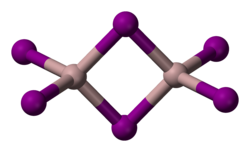Aluminum iodide
| Structural formula | ||||||||||||||||
|---|---|---|---|---|---|---|---|---|---|---|---|---|---|---|---|---|

|
||||||||||||||||
| __ Al 3+ __ I - | ||||||||||||||||
| General | ||||||||||||||||
| Surname | Aluminum iodide | |||||||||||||||
| other names |
|
|||||||||||||||
| Molecular formula | AlI 3 | |||||||||||||||
| Brief description |
White dust |
|||||||||||||||
| External identifiers / databases | ||||||||||||||||
|
||||||||||||||||
| properties | ||||||||||||||||
| Molar mass | 407.70 g mol −1 | |||||||||||||||
| Physical state |
firmly |
|||||||||||||||
| density |
3.98 g cm −3 (25 ° C) |
|||||||||||||||
| Melting point |
191 ° C |
|||||||||||||||
| boiling point |
360 ° C |
|||||||||||||||
| Vapor pressure |
1 hPa (178 ° C) |
|||||||||||||||
| solubility |
|
|||||||||||||||
| safety instructions | ||||||||||||||||
|
||||||||||||||||
| Thermodynamic properties | ||||||||||||||||
| ΔH f 0 |
−302.9 kJ / mol |
|||||||||||||||
| As far as possible and customary, SI units are used. Unless otherwise noted, the data given apply to standard conditions . | ||||||||||||||||
Aluminum iodide is a chemical compound from the group of iodides .
Extraction and presentation
Aluminum iodide can be obtained by reacting aluminum with iodine .
properties
Aluminum iodide is a white powder made up of colorless flakes. It is sensitive to moisture and decomposes when heated in air to form iodine and aluminum oxide . It crystallizes in a monoclinic structure with the space group P 2 1 / c (space group no.14 ) , a = 9.591 Å, b = 6.069 Å, c = 11.902 Å, β = 108.05 °, in which it is called the dimer Al 2 I 6 is present.
use
Aluminum iodide is used in organic synthesis as a catalyst to break certain types of C – O and N – O bonds. It splits aryl ethers and decomposes epoxides . It can also be used to make iodinated organic compounds.
Individual evidence
- ↑ a b c d e f g data sheet Aluminum iodide, anhydrous, powder, 99.999% trace metals basis from Sigma-Aldrich , accessed on February 12, 2012 ( PDF ).
- ↑ a b Physical constants of inorganic compounds. In: CRC Handbook of Chemistry and Physics . 88th edition, CRC Press, Boca Raton, FL 2007-2008, pp. 4-43.
- ↑ a b Entry on aluminum iodide in the GESTIS substance database of the IFA , accessed on July 23, 2016(JavaScript required) .
- ↑ David R. Lide (Ed.): CRC Handbook of Chemistry and Physics . 90th edition. (Internet version: 2010), CRC Press / Taylor and Francis, Boca Raton, FL, Standard Thermodynamic Properties of Chemical Substances, pp. 5-5.
- ↑ a b Georg Brauer (Ed.), With the collaboration of Marianne Baudler u a .: Handbook of Preparative Inorganic Chemistry. 3rd, revised edition. Volume II, Ferdinand Enke, Stuttgart 1978, ISBN 3-432-87813-3 , p. 876.
- ↑ SI Troyanov, T. Krahl, E. Kemnitz: Crystal structures of GaX 3 (X = Cl, Br, I) and AlI 3 . In: Zeitschrift für Kristallographie , 2004 , 219 , pp. 88-92 doi : 10.1524 / zkri.219.2.88.26320
- ↑ John C. Bailar: Inorganic Syntheses . 1953, p. 118 ( limited preview in Google Book search).
- ↑ John C. Kotz, Paul Treichel, Gabriela C. Weaver: Chemistry & chemical reactivity . 2005, ISBN 978-0-534-99766-3 , pp. 1038 ( limited preview in Google Book search).
- ↑ M. Gugelchuk: Aluminum Iodide. In: L. Paquette (Ed.): Encyclopedia of Reagents for Organic Synthesis. J. Wiley & Sons, New York 2004, doi : 10.1002 / 047084289X.ra083 .
- ↑ Sung Lee, Geum-Sook Hwang, Do Ryu: Aluminum Iodide Promoted Highly Z-Stereoselective Synthesis of β-Iodo Morita-Baylis-Hillman Esters with Ketones as Aldol Acceptors . In: Synlett . tape 2007 , no. 1 , 2007, p. 59-62 , doi : 10.1055 / s-2006-958421 .



